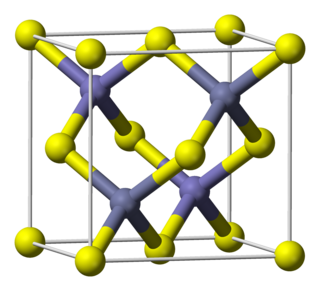
Aluminium gallium arsenide (AlxGa1−xAs) is a semiconductor material with very nearly the same lattice constant as GaAs, but a larger bandgap. The x in the formula above is a number between 0 and 1 - this indicates an arbitrary alloy between GaAs and AlAs.

Gallium arsenide (GaAs) is a III-V direct band gap semiconductor with a zinc blende crystal structure.
A heterojunction bipolar transistor (HBT) is a type of bipolar junction transistor (BJT) that uses different semiconductor materials for the emitter and base regions, creating a heterojunction. The HBT improves on the BJT in that it can handle signals of very high frequencies, up to several hundred GHz. It is commonly used in modern ultrafast circuits, mostly radio frequency (RF) systems, and in applications requiring a high power efficiency, such as RF power amplifiers in cellular phones. The idea of employing a heterojunction is as old as the conventional BJT, dating back to a patent from 1951. Detailed theory of heterojunction bipolar transistor was developed by Herbert Kroemer in 1957.

Indium antimonide (InSb) is a crystalline compound made from the elements indium (In) and antimony (Sb). It is a narrow-gap semiconductor material from the III-V group used in infrared detectors, including thermal imaging cameras, FLIR systems, infrared homing missile guidance systems, and in infrared astronomy. Indium antimonide detectors are sensitive to infrared wavelengths between 1 and 5 μm.
Indium gallium arsenide (InGaAs) is a ternary alloy of indium arsenide (InAs) and gallium arsenide (GaAs). Indium and gallium are group III elements of the periodic table while arsenic is a group V element. Alloys made of these chemical groups are referred to as "III-V" compounds. InGaAs has properties intermediate between those of GaAs and InAs. InGaAs is a room-temperature semiconductor with applications in electronics and photonics.

An infrared detector is a detector that reacts to infrared (IR) radiation. The two main types of detectors are thermal and photonic (photodetectors).

Zinc telluride is a binary chemical compound with the formula ZnTe. This solid is a semiconductor material with a direct band gap of 2.26 eV. It is usually a p-type semiconductor. Its crystal structure is cubic, like that for sphalerite and diamond.
Aluminium gallium indium phosphide is a semiconductor material that provides a platform for the development of multi-junction photovoltaics and optoelectronic devices. It has a direct bandgap ranging from ultraviolet to infrared photon energies.
Gallium arsenide phosphide is a semiconductor material, an alloy of gallium arsenide and gallium phosphide. It exists in various composition ratios indicated in its formula by the fraction x.

Gallium antimonide (GaSb) is a semiconducting compound of gallium and antimony of the III-V family. It has a room temperature lattice constant of about 0.610 nm. It has a room temperature direct bandgap of approximately 0.73 eV.
Aluminium indium arsenide, also indium aluminium arsenide or AlInAs (AlxIn1−xAs), is a ternary III-V semiconductor compound with very nearly the same lattice constant as InGaAs, but a larger bandgap. It can be considered as an alloy between aluminium arsenide (AlAs) and indium arsenide (InAs). AlInAs refers generally to any composition of the alloy.
Gallium indium arsenide antimonide phosphide is a semiconductor material.
Indium arsenide antimonide phosphide is a semiconductor material.

Interband cascade lasers (ICLs) are a type of laser diode that can produce coherent radiation over a large part of the mid-infrared region of the electromagnetic spectrum. They are fabricated from epitaxially-grown semiconductor heterostructures composed of layers of indium arsenide (InAs), gallium antimonide (GaSb), aluminum antimonide (AlSb), and related alloys. These lasers are similar to quantum cascade lasers (QCLs) in several ways. Like QCLs, ICLs employ the concept of bandstructure engineering to achieve an optimized laser design and reuse injected electrons to emit multiple photons. However, in ICLs, photons are generated with interband transitions, rather than the intersubband transitions used in QCLs. Consequently, the rate at which the carriers injected into the upper laser subband thermally relax to the lower subband is determined by interband Auger, radiative, and Shockley-Read carrier recombination. These processes typically occur on a much slower time scale than the longitudinal optical phonon interactions that mediates the intersubband relaxation of injected electrons in mid-IR QCLs. The use of interband transitions allows laser action in ICLs to be achieved at lower electrical input powers than is possible with QCLs.
Aluminium indium antimonide, also known as indium aluminium antimonide or AlInSb (AlxIn1-xSb), is a ternary III-V semiconductor compound. It can be considered as an alloy between aluminium antimonide and indium antimonide. The alloy can contain any ratio between aluminium and indium. AlInSb refers generally to any composition of the alloy.
Aluminium gallium antimonide, also known as gallium aluminium antimonide or AlGaSb (AlxGa1-xSb), is a ternary III-V semiconductor compound. It can be considered as an alloy between aluminium antimonide and gallium antimonide. The alloy can contain any ratio between aluminium and gallium. AlGaSb refers generally to any composition of the alloy.
Gallium arsenide antimonide, also known as gallium antimonide arsenide or GaAsSb, is a ternary III-V semiconductor compound; x indicates the fractions of arsenic and antimony in the alloy. GaAsSb refers generally to any composition of the alloy. It is an alloy of gallium arsenide (GaAs) and gallium antimonide (GaSb).
Indium arsenide antimonide, also known as indium antimonide arsenide or InAsSb (InAs1-xSbx), is a ternary III-V semiconductor compound. It can be considered as an alloy between indium arsenide (InAs) and indium antimonide (InSb). The alloy can contain any ratio between arsenic and antimony. InAsSb refers generally to any composition of the alloy.
Gallium indium antimonide, also known as indium gallium antimonide, GaInSb, or InGaSb (GaxIn1-xSb), is a ternary III-V semiconductor compound. It can be considered as an alloy between gallium antimonide and indium antimonide. The alloy can contain any ratio between gallium and indium. GaInSb refers generally to any composition of the alloy.






